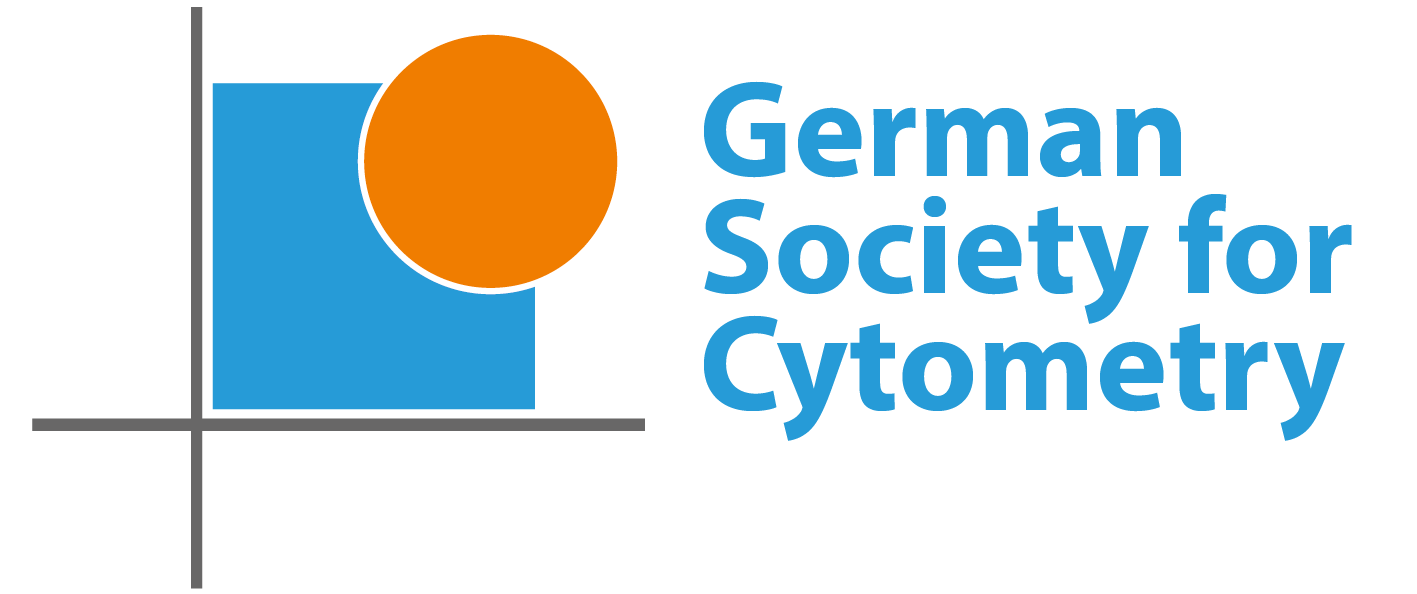Cutting Edge
Cutting Edge Session
Tuesday, September 19th, 2023, at 3:30 pm
Chairs: Bertram Bengsch & Henrik Mei
Cutting edge cytometric technologies are at the forefront of technological R&D in single cell sciences. New concepts continuously emerge, and many of these will shape the way of future routines in cell analysis. This years programme features mass cytometry is a relatively new hybrid technology for generating high-dimensional single cell data. Emerging from single-cell analysis of cell suspensions with the help of metal isotope conjugated antibodies and a mass spectrometric readout adopted from trace element analysis, it today is often used for creating high resolution multiplexed imaging data of tissue sections, giving rise to multiple partly commercially available imaging platforms undergoing further development. In hindsight, mass cytometry is the disruptive technology that not only pioneered highly multiplexed single cell analysis but also stimulated the further advancement of fluorescence-based technologies, and the adoption of bioinformatics tools to analyze the new wealth of data. Mass cytometry remains a thrilling field of active interdisciplinary innovation with involvement of chemistry, mass spectrometry, flow cytometry, imaging and bioinformartics. The cutting edge: mass cytometry sessions features speakers with excellent contributions to wet lab and data analysis workflows in mass cytometry and imaging mass cytometry, and showcases exemplary applications in stem cell research and translational immunology.

Through the lens of CyTOF: resolving signatures of muscle stem cell aging one cell at the time
Affiliation
Aarhus University, Department of Biomedicine, Aarhus, Denmark
Baxter Laboratory for Stem Cell Biology, Stanford University School of Medicine; Stanford, USA
Abstract
Skeletal muscle mass, strength and regenerative capacity progressively decline with aging. This is partly due to functional impairment of muscle stem cells (MuSCs), the key players in muscle regeneration. However, the mechanisms responsible for age associated MuSC dysfunction remain elusive. A major barrier to gaining mechanistic insights into MuSC aging is the increased functional heterogeneity of the aged MuSC population, underscoring the need for single-cell studies. Here we capitalized on single cell mass cytometry to resolve MuSC heterogeneity during aging and identified a dysfunctional MuSC subset, marked by high CD47 surface expression (CD47hi). Mechanistically, increased expression of U1 snRNA in aged MuSCs shifted the balance of CD47 mRNA isoforms, leading to increased levels of CD47 protein on the cell surface. Aged CD47hi MuSCs act via paracrine signaling, through secretion of thrombospondin-1, a ligand for CD47, to suppress the regenerative capacity of CD47lo MuSCs. Strikingly, in vivo thrombospondin-1 blockade restored the proliferative potential of aged MuSCs and enhanced muscle regeneration and strength in aged mice. These findings uncover an unexpected role for thrombospondin-1/CD47 signaling in aged MuSCs and suggest a novel therapeutic approach to improve muscle regenerative function in the elderly.
Biosketch
Dr. Ermelinda Porpiglia is a tenure-track Assistant Professor at Aarhus University, Denmark, and an Associate Fellow at the Aarhus Institute of Advanced Studies (AIAS). Her research interest is to understand how aging impairs tissue regeneration. During her postdoctoral training at Stanford University, she pioneered the application of single-cell mass cytometry (CyTOF) to skeletal muscle, to identify rare stem cell populations that accumulate during aging and understand how they affect muscle regeneration. Her laboratory at Aarhus University, employs novel single-cell technologies, such as single-cell mass cytometry (CyTOF) and imaging mass cytometry, to map stem cell niche dynamics at single cell resolution and study the relationships between muscle stem cells and immune cells in skeletal muscle, in the context of aging and muscle diseases. Her long-term research goal is to develop therapeutic strategies to modulate the immune system in order to boost muscle tissue repair. Dr. Porpiglia’s research has been published in top scientific journals, including Nature Medicine, Nature Cell Biology and Cell Stem Cell. She holds a BS/MS degree in Medical Biotechnology from the University of Bologna Medical School, Italy, and a Ph.D. in Biomedical Sciences from the University of Massachusetts Medical School, USA. Dr. Porpiglia completed her postdoctoral training in the Blau lab at Stanford University, where she established a long-standing collaboration with the Nolan lab.

Spatially and temporally resolved pathology of COVID-19 in the lung
Affiliation
CeMM Research Center for Molecular Medicine of the Austrian Academy of Sciencesation, Vienna, Austria
Abstract
In this talk I will present how high-parameter flow cytometry, metabolomics, imaging mass cytometry, single-cell RNA-seq, and spatial transcriptomics can be used to explore unique facets of COVID-19 pathophysiology. These methods enabled us to dissect the intricate host response at systemic and tissue level during severe and fatal SARS-CoV-2 infection. We unravel substantial alterations in cellular composition and transcriptional cell states, as well as the intricate interplay between infected cells and the immune system at sites of infection in acute lung injury caused by COVID-19. In particular, multiplexed imaging with imaging mass cytometry offered us crucial understanding of the disordered lung structure and extensive immune infiltration, and by employing a comparative approach we were able to identify unique features of SARS-CoV-2 infection compared to other respiratory pathogens. Finally, I will highlight our most recent results on the long term, post-acute effects of SARS-CoV-2 infection in the lung by studying a cohort of patients followed for up to 359 days after infection. Altogether, these methods offer highly complementary insights into a landscape of lung pathology during COVID-19 and lung diseases in general.
Biosketch
I am a Principal Investigator at CeMM – the Research Center for Molecular Medicine of the Austrian Academy of Sciences leading a research group on computational and molecular methods to study human aging and pathology. My group develops computational methods for the analysis of spatial data (spatial transcriptomics, highly multiplexed imaging), and its integration with various modalities of molecular and clinical data of individuals along their lifespan. I am particularly interested in the organization of cells at the micro-anatomical level and understanding how this changes during the lifespan of individuals and at the onset of disease.
Alexandra Emilia Schlaak
Development of a competitive tetramer assay that allows mass-cytometry profiling of epitope-specific CD8+ T Cells after bead enrichment
Clinic for Internal Medicine II, Freiburg University Medical Center, Faculty of Medicine, University of
Freiburg, Freiburg, Germany
Background The characterization and phenotyping of epitope-specific CD8+ T cells represent a significant area of research. Existing methods, such as tetramer enrichment using magnetic beads against fluorophore-tagged tetramers, enable the enrichment and detection of low frequencies of epitope-specific cells. However, a crucial limitation has been the inability to detect these cells by mass cytometry after tetramer enrichment.
Methods CMV-tetramers were generated from monomers which were tetramerized using either a) fluorophore-conjugated streptavidin, b) metal-conjugated streptavidin or c) streptavidin conjugated to both a fluorophore and a metal. PBMCs with a known CMV response were incubated with either fluorophore-tagged tetramer and metal-tagged tetramer simultaneously
(“competitive tetramer assay”), or a fluorophore and metal double-tagged tetramer (“double labelling assay”). Then, tetramer-based enrichment of epitope-specific T cells and CyTOF staining was performed and compared to flow cytometry analysis. The strategy was further evaluated for additional epitope specificities in PBMCs or antigen-specific CD8+ T cell lines
(FLU, EBV, HBV, HCV).
Results Both the competitive tetramer assay and the double labelling assay were able to successfull
enrich epitope-specific CD8+ T cells and simultaneously allow the detection via mass cytometry, enabling further multiparametric characterization. We observed a reduced tetramer signal intensity in the competitive tetramer assay compared to common tetramer staining, but this did not impact the ability to identify similar frequencies of epitope-specific CD8+ T cells as
in control stainings.
Conclusions Our study introduces two innovative strategies to bridge the gap between tetramer enrichment and CyTOF staining. These approaches provide researchers with novel tools to further explore the phenotypic and functional characteristics of epitope-specific CD8+ T cells.
Axel Ronald Schulz
Vaccinology meets mass cytometry – Identifying baseline predictors of vaccination outcome
German Rheumatism Research Center, Berlin, a Leibniz-Institute, Berlin, Germany
Vaccination effectively protects from severe consequences of infection. However, little is known about immunological determinants of vaccination success in humans, specifically in groups with variable/poor vaccination response. We deeply profiled peripheral blood leukocytes by mass cytometry in cohorts of older (>80 years, n=55) and younger adults (20–53 years, n=44) before receiving at least two doses of BNT162b2 mRNA vaccine and correlated the data with the SARS-CoV-2-specific response data. Vaccination responses expectedly varied stronger among older compared to younger individuals, including older individuals with nearly no detectable T- and B-cell responses (Romero-Olmedo & Schulz et al., Nat Microbiol 2022, Lancet Infect Dis 2022).
While our mass cytometry data reproduced known features of immune ageing in senior adults, such as decreased frequencies of naive CD4+ CD31+ recent thymic emigrants, gamma-delta T cells, and plasmacytoid dendritic cells, we additionally identified clear signatures of high and low responsiveness among senior vaccinees. Older individuals with high antibody responses were characterized, by increased frequencies of proinflammatory, intermediate CD16+CD14++ and non-classical CD16+CD14+/- monocytes as well as proinflammatory CD38+CD11c+ NK cells. This suggests an unexpected beneficial role of these immune subsets for the vaccination response in elderly vaccinees, whereas they are usually considered detrimental to vaccine responsiveness in young individuals. In contrast, older subjects with low antibody response showed fewer transitional CD38+ naive B cells and more early immature neutrophils in the blood, most likely reflecting an imbalance in lymphopoiesis vs. neutropoiesis, which was confirmed by an increased Neutrophil-Lymphocyte-Ratio (NLR) in poor responders.
Altogether, we here report immune signatures associated with the success of mRNA vaccination in senior adults that can be of relevance in the clinical practice, i.e. to prospectively identify individuals that may require additional doses or differently formulated vaccination to achieve protection. In light of the development of a range of new mRNA-based vaccines, our results provide important clues to immune mechanisms underlying the magnitude of the vaccine response in the elderly, who represent a large at-risk population that needs to be protected by vaccination.
Toni Sempert
Single-cell microbiota phenotypes for classification of chronic-inflammatory diseases and functional characterization to decipher their role in pathophysiology
German Rheumatism Research Center, Berlin, a Leibniz Institute and Department for Cytometry, Institute of Biotechnology, Technische Universität Berlin, Berlin, Germany
Chronic-inflammatory diseases (CID) show alterations in mucosal immune response and composition of intestinal microbiota, referred to as dysbiosis. We determine cellular properties of human gut microbiota from stool samples on single cell-level with multi-parameter microbiota flow cytometry (mMFC). We capture the mucosal immune response of the host by isotype-specific stainings of bacterial coating with endogenous host immunoglobulins and the expression of specific sugar moieties on the bacterial surface by staining with plant-derived lectins, potentially reflecting adaption of the bacteria to altered micro-environmental conditions in the intestine. By using machine-learning, we identified disease-specific phenotypic signatures for different CIDs such as Crohn’s Disease (CD), Ulcerative Colitis, Rheumatoid Arthritis and IgG4-related diseases. To understand the link between single-cell bacterial phenotypes and its function in disease pathophysiology, we combine cell sorting of bacteria with particular phenotypes with a deeper molecular and functional characterization. Preliminary data show an enrichment of disease-specific pathobionts for host immunoglobulins across patients, suggesting that the immune system recognizes distinct species in the context of intestinal inflammation. This is not reflected in the lectin staining of the bacteria, which may rather reflect a response of the bacteria to an altered, inflammatory environment. We will aim to link the phenotypic characterization of the microbiota to the phenotypic and functional analysis of the host’s immune system. By this, we hope to unravel the communication between bacteria of the intestinal microbiota and our immune system and determine its role in health and disease.
